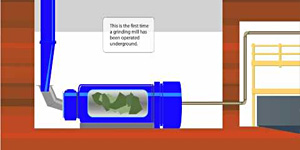Obtaining the Ore
Mining uranium involves the same processes used to mine many other metals. Depending on the deposit, uranium is mined in one of three ways. Deposits close to the surface can be recovered using the open pit mining method. Underground mining methods are used for deep deposits. In some circumstances, ore may be mined by in situ recovery, a process that dissolves the uranium while still underground and then pumps a uranium-bearing solution to the surface.
Open pit mining
When uranium ore is found near the surface, generally less than 100 metres deep, it is typically extracted by open pit mining. Soil and waste rock is removed using conventional earth moving processes to access the ore. The walls of the pit are mined in a series of benches to prevent them from collapsing. To mine each bench, holes are drilled into the rock and loaded with explosives, which are detonated to break up the rock. The resulting broken rock is loaded into large trucks that carry up to 200 tonnes of material and hauled to a mill for processing.
Underground mining
It's generally not practical or economic to use the open pit method to mine uranium orebodies located more than 100 metres below the surface. Underground mining methods may be used mine such deposits if the grade and quantity of ore is sufficient. For example, Cameco's McArthur River and Cigar Lake orebodies are located between 400 and 600 metres below the surface. The high ore grades of these deposits, about 100 times the world average, allow underground mining.
The first step in underground mining is to access the ore. Access to underground deposits is gained by digging vertical shafts or declines to the depth of the ore. A series of horizontal tunnels, ramps and chambers are then developed to access the ore. Uranium ore can be removed using a range of mining methods depending upon the characteristics of the deposit.
At the McArthur River mine, a raisebore method is employed, which requires development above and below the orebody. In this method, a revolving reaming head is pulled up through the orebody creating a vertical tunnel or raise. Ore falls through the raise to the lower chamber where it is collected using remote-controlled front-end loaders and delivered to underground processing circuits where it is ground, mixed with water, and pumped to the surface in slurry form. Once a raise is completed, the opening in the rock is backfilled with concrete.
At Cigar Lake, Cameco plans to use a jet-bore mining method that will use highly pressurized water to remove the ore. The jet-bore system will be deployed in tunnels beneath the deposit to spray out cavities in the orebody. The resulting mixture of ore and water is then piped to underground processing circuits where it will be ground, thickened and pumped to the surface. As at McArthur River, the cavities from which the ore has been removed will be backfilled with concrete.
Cameco's Eagle Point underground mine uses more conventional stoping methods where ore is broken by drilling and blasting, and then loaded into trucks drill and hauled to the surface up a winding ramp.
In situ recovery
Some uranium deposits are mined from surface by pumping mining solutions underground to dissolve uranium and collect it using a system of wells. The surrounding rock remains in place while the dissolved uranium is pumped to the surface then circulated through a processing plant for extraction. The in situ recovery (ISR) process involves minimal surface environmental disturbance and does not produce waste rock or tailings. ISR is suitable for certain deposits such as the Inkai mine in Kazakhstan.









